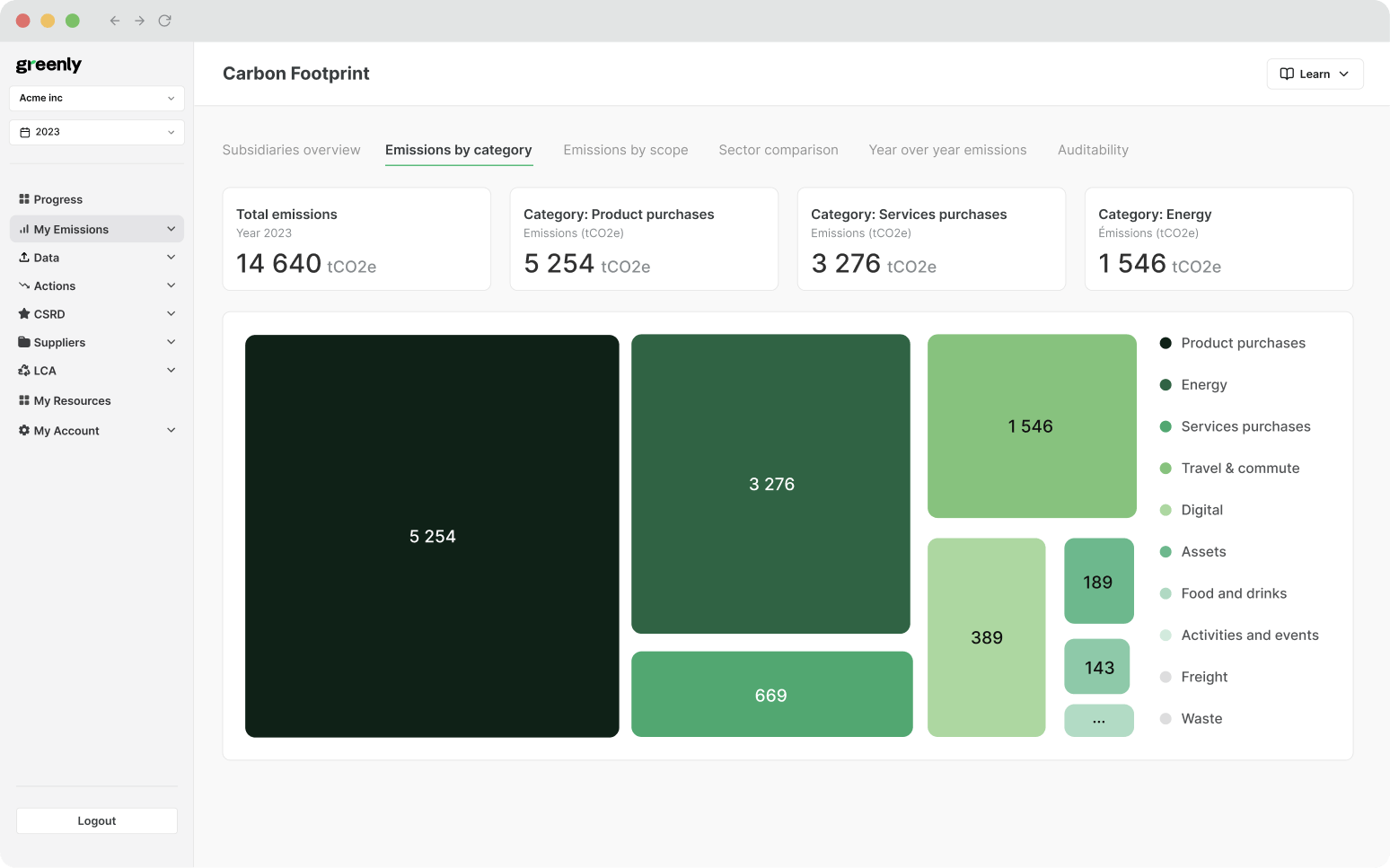
California Climate Accountability Package: SB253, SB261, & SB252
What is the California Climate Accountability Package, and how do SB 253 and SB 261 (SB 219), and SB 252 help the state work towards their environmental goals?
ESG / CSR
Industries



Today, many companies use different terms to describe their carbon emissions status, such as the term "carbon positive".
These labels are meant to help others quickly recognize their ambition to tackle climate change. However, the spread of new terms can unintentionally confuse people who aren't familiar. This can be off-putting, even for people who care about the climate.
Carbon positive is just one example of a phrase that has the potential to confuse people. In this article, we explain why terms such as carbon positivity, achieving carbon neutrality, or net zero emissions can be confusing while also offering a wide range of ways to communicate your ambitious carbon emissions reduction plans.

The phrase “carbon positive” is one of the least popular phrases used in corporate carbon emissions accounting today – as people often get confused on the differences between carbon positivity, carbon negative, and carbon neutrality.
This is because descriptors such as “positive” or “negative” have two different meanings in carbon emissions lingo: they can refer to quantities above or below zero, or refer to qualitatively good or bad actions. The problem is if they're misunderstood, it could reverse your intended meaning and spread misinformation regarding the intent of these two phrases referring to carbon emitted and absorbed.
The main difference between carbon positive and carbon negative is that carbon positive refers to a company which still adds carbon to the atmosphere, whereas carbon negative refers to an even stronger commitment where a company removes more carbon dioxide from the atmosphere than it emits.
The battle cards below will break down the differences between carbon negative and carbon positive
Remember, being carbon positive means your business emissions are above zero – which worsens climate change. In fact, most businesses are carbon positive, because it is incredibly difficult to remove more carbon than you produce, today.
However, if you say your business is carbon negative, it means your business emissions are below zero because you've removed more CO₂ than you emitted. This phrase suggests your actions have contributed to mitigating climate change.
Let's look at the full range of descriptions used to classify progress in reducing carbon emissions:


Of all the terms frequently confused with carbon positivity, carbon negative and climate positive represent the most optimal emissions reduction performance since they refer to removing more CO₂ emissions than a company produces.
If more businesses around the world achieved this, we would effectively start to reduce the total amount of CO₂ emissions currently sitting in the atmosphere. This would help to stabilize our climate temperature to safe levels. Environmentally friendly business means lower long-term risk to our planet, people, and the economy.
This long-term goal is ambitious, but by no means is it impossible.
Just remember that progress won't happen overnight. Most businesses start by setting goals to become carbon neutral before they strive towards carbon negative operations, as the latter is a more demanding endeavor which further mitigates greenhouse gas emissions.
It is important to work towards climate positivity as we're witnessing unprecedented environmental changes, and with it comes a newfound demand for business sustainability related to climate change – of which climate positivity can help to satisfy.
There is no denying the link between climate change and the noticeable effects of hurricanes, polar ice melting, droughts, and wildfire hazards we're now experiencing each year. These risks not only threaten communities, but they harm our global economy as a whole.
Furthermore, these natural disasters are occurring on a scale humans have never seen before – with hundreds of thousands of people forced to evacuate from their own homes as a result of climate-induced weather events in 2024 alone.
However, it's complicated as a business owner to address a serious, but slow-moving, long-term issue. According to the Royal Society, evidence regarding the negative impact of climate change has built up over the past five decades – and yet, people are only taking in interest in mechanism such as soil carbon sequestration, carbon capture, and carbon offsetting now.
First off, transitioning to a low-carbon business model matters more than ever to the most important stakeholders for businesses–their customers and investors.
Another factor is the growing alignment among policymakers, business leaders, and markets facilitating cost-effective strategies to act on climate. Even for businesses owners focused on profit, there are beneficial economic reasons to reduce carbon emissions, too.
The drop down sections below will provide a brief summary of the reasons why businesses are more inclined to pursue effective emission reduction tactics in 2025:
More investors now favor companies with credible emissions strategies, as ESG metrics influence long-term profitability and risk reduction.
New climate-related regulations and carbon pricing mechanisms are increasing the financial cost of inaction, pushing companies to act.
Customers and partners expect greener practices. Businesses that prioritize emissions reduction gain reputational and strategic advantages.
Energy-efficient operations and renewable energy investments can lead to substantial long-term savings and resource stability.
Here's a more detailed breakdown of why companies are taking a greater interest in sustainable practices, removing carbon from the atmosphere, and fighting against global warming:
Marketing surveys have confirmed the growing number of sustainability-minded customers. More notably, however, is their willingness to act on their values.
A 2018 Futerra study estimates 96% of people believe their own sustainable actions can make a difference and 88% want brands to help them amplify this impact. This trend has continued, as five years later in 2023 – there has been a 71% increase in online searches for more sustainable products.
A Dentsu International and Microsoft Advertising survey conducted in 2021, which included 24,000 people across 19 countries – found 59% of customers are willing to boycott businesses that fail to take environmental action in their businesses within 12 months of complaints.
On the other hand, customers find environmental PR hard to judge: with 61% of customers interested in more information to make better choices, but only 20% seeking to verify the claims made in sustainability campaigns. However, a 2020 IBM survey suggests that consumers do indeed care about carbon emissions data – even if they don't make an extensive effort to verify the validity of environmental campaigns.
It shows that almost 4 out of 5 Americans say it's important that brands are sustainable and environmentally responsible, and nearly 6/10 would choose to reduce emissions and environmental impact by changing their shopping habits.
Finally, more Gen Z customers (75%) are willing to pay more than other age groups for sustainable products, according to a survey from First Insight.
All of these statistics show the power of sustainability to influence customers, and gain loyal supporters. The sustainability mega-trend is expected to continue growing as climate impacts become more severe, and younger people gain more influence over the marketplace as they age.

Investors are using their leverage to bring more companies on board with carbon accounting and emissions reduction efforts. Lower carbon emissions equals more than just environmental awareness, studies have shown it lowers risk for investors.
An investor survey conducted by EY on climate and sustainability found that 98% of investors assess environmental and other sustainability factors in corporate reports. The majority of these respondents (72%) said they use a structured approach for evaluation.
The problem is companies aren't providing enough environmental risk information, according to most respondents to the EY survey (86%).
Providing carbon emissions data is a critical first step to helping investors make better judgments about the sustainability risks for companies.
If carbon emissions reduction sounds like a costly, difficult challenge, consider how it's actually done. To lower emissions, you'll need to lower the use of energy sourced from fossil fuels or help others do this.
Recent changes to oil and gas prices show that fossil fuels are notoriously volatile. It can be hard to hinge financial performance on energy sources with such variable costs.
In contrast, solar energy became the cheapest source of energy–throughout history–according to the IEA. This is not that surprising, since the sun is the most abundant source of freely accessible energy on earth.
The other thing worth mentioning is switching to renewables and avoiding fossil fuel costs in other ways like energy efficiency is a boon to the bottom line of businesses – as sustainable business leaders care about efficiency beyond convenience.
The flip cards (move your cursor over the card to flip) will reveal how sustainable initiatives can not only provide an environmental benefit, but how utilizing renewable energy sources or carbon capture technologies can be beneficial for business long-term:
These leaders are dedicated to untangling the true costs of shipping, supply chains, and raw materials in ways that unveil smarter ways of doing business. This is because shorter trips, digitally enhanced processes, and resource efficiency can all reduce both environmental impacts and financial costs.
Ultimately, sustainable business can cost less while customers perceive it as more valuable. That's a win-win business model.

On the path to becoming climate positive, there is one imperative first step every business should take. It isn't lowering energy consumption or declaring a climate goal. Before any of the buzzworthy eco-friendly actions comes number crunching in the form of a carbon emissions assessment.
If the words “carbon emissions assessment” sound daunting, don't worry – it's simply a way of saying you'll need to identify which business activities emit CO₂ and how much over the course of an entire year.
The result is a business carbon footprint, which is a quick overview of the main sources of emissions for a business.
It's important to establish a clear methodology for your carbon emissions measurement, as it can help your company to reduce emissions more effectively. This methodology is what investors and other stakeholders will look to to interpret your data.
At Greenly, we perform carbon assessments using an ADEME method as an authorized service provider. We start by assessing business bank expense reports. We use secure banking synchronization to analyze the CO₂ emissions of a business.
To add a layer of complexity onto these consumption quantities, we also use a questionnaire to assess operational consumption patterns. This reveals why and how an organization depends on CO₂ emitting processes related to food, equipment, transportation, and more.
Here are the steps we take to deliver our carbon footprinting service:
1. Identify All Sources of Emissions
Emissions source data comes from internal reports, external bills and receipts, and local authorities. Greenly uses specific parameters for each business case to identify the full range of emissions sources.
Collecting data can take anywhere from a week to several months depending on the size of the organization.
2. Calculate CO₂
For every emissions source identified, the emissions type and quantity will be translated into an equivalent amount of CO₂.
3. Prioritize Steps to Reduce Emissions
The information gathered from CO₂ measurement holds powerful insights into the best ways to reduce CO₂. After acquiring this information, businesses can develop a detailed plan to minimize their CO₂ emissions in terms of ease of implementation as well as size of impact.
4. Share the Results
Reporting a company's carbon emissions plan shows commitment to climate action. It also prepares organizations for legal compliance with emerging climate risk reporting standards.
Remember, you shouldn't limit your results the board room. The report should be available for employees, customers, and board members alike to help establish transparency, CSR, and overall commitment to environmental improvement.

The two main ways to reduce your business carbon footprint are by reducing emissions and offsetting. To become climate positive, you can nearly reach the net zero line with reductions alone. However, to move into carbon negative territory, offsetting tactics are required.
The summary cards below will outline the differences between these two initiatives to mitigate atmospheric carbon
For each, there are numerous strategies a business can employ.
Reducing carbon emissions sounds simple, and in some ways it is. However, the complexity lies in considering life cycle emissions for every action a business takes.
For instance, replacing a fleet with electric vehicles sounds great in theory. However, if your region primarily supplies its electricity with coal, this might not accomplish the CO₂ emission reductions your business initially aimed to achieve. Electric cars also use more CO₂ in their production than conventional cars.
This example shows that not every “environmental swap” successfully pans out. It's important to track and measure emissions every step of the way.
Some of the most popular ways to reduce a carbon footprint are:
Offsetting carbon emissions means removing CO₂ from the atmosphere by funding projects external to an organization or separately from normal operations.
Offsetting projects follow a precise method to ensure they are high quality and effective at removing CO₂ emissions.
The key principles are:
Here are some different types of projects businesses can invest in to offset emissions:
Companies can use both CO₂ reduction and offsets to form a strategy that can achieve a carbon negative CO₂ emissions balance.
The good news is that the possibilities for carbon emissions reduction are far more diverse than they've ever been. It's an exciting time to get involved in carbon management, and at Greenly – we can help your company to employ energy efficiency measures, reduce additional carbon dioxide, and remaining emissions to reduce your company's carbon footprint and work towards a more sustainable future.
If reading this article about what it means to be carbon positive has made you interested in reducing your emissions and going green – look no further for help to start your climate journey than with Greenly!
Greenly is the perfect partner for launching a climate positive business initiative as we can supply you with all the data you'll need to be successful in your climate journey. We've simplified carbon to make them easy to complete, giving businesses clarity on the actions they'll need to effectively reducetheir CO₂ emissions.
